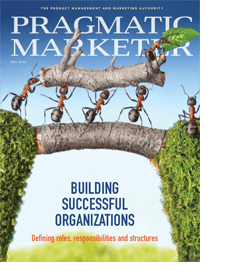
Introducing the 3 Pillars
Creating a deeply rooted alignment between your company and your customer’s business rests on these three pillars:
- Align with your customers by adopting an outside-in point of view.
- Focus on why you’re selected.
- Accelerate the sales cycle by understanding how your customers think and make decisions.
Despite their huge impact, the three pillars are often overlooked because they don’t tie directly to a company’s tangible products. But it’s actually a feature, not a bug, that the pillars do not directly relate to tangible products and what can become obsessive efforts at differentiation. Let’s look at each of the three pillars in greater depth, including what’s at stake and tips for implementing them at your company.
Pillar 1: Point of View
Adopt an outside-in point of view to align with your customers.
Stop talking about your product and focus on how the entire experience of working with your company will improve your customer’s business. Even if your product is a commodity, the relationship with your customer isn’t. Conversely, your widget may be faster, but unless you can tie widget speed to improving their business, your customer won’t care.
It’s a challenge to change your point of view when nearly everyone at your company—not only marketers—perceives the customer through their own lens. Remember, customers want to talk about their business, not yours, so an inside-out point of view is a hurdle to customer alignment.
An outside-in perspective shifts the focus from your product and how it is used to how your company improves the customer’s business. However, adopting this point of view requires more than talk; it requires a mental shift in your thinking.
It can be humbling when customers see your business differently than you think they should. The payoff of embracing an outside-in approach is seeing your business the same way your customers do. The good news is that little things can make a big difference. And while it may sound like hyperbole, you will never market the same way again.
Don’t Limit Yourself to Product Benefits
Don’t limit your impact to the direct application of your product. Understand every way your company improves the customer’s business (product, service, support, relationship, etc.). It’s easy to spot the impact of a widget that resolves a bottleneck. But it’s also a rarity. I see plenty of examples where the indirect impact—for example, the service commitment that keeps a production line running as a byproduct—exceeds the product’s direct impact.
Customers love it when your company aligns with their overall success. Meanwhile, if your competitors focus on minutiae that they claim are critical, this can gain your company an edge. Even if your competitor’s product is indistinguishable from your own, simply speaking in terms of the customer’s business—rather than yours—will cause buyers to gravitate to your company. When you are aligned with their interests, they feel you “get” them.
Encourage this mental shift in your thinking by asking yourself whether each action or communication truly focuses on the customer and improves their business, or whether it is about you. When you can see your business through the same lens as your customers, it will prepare you to take the next step and identify the real reasons why they buy from your company.
[Sidebar/example]
A series of customer interviews revealed that customers bought a cybersecurity company’s solution not to secure their data, but to accelerate regulatory compliance. The insight—that compliance was viewed as a higher priority than security—became a competitive advantage. By aligning with their customers, the company shifted positioning to embrace compliance as a precursor to security.
Pillar 2: The Selection Process
See beyond your product to focus on why your company gets selected.
Chances are, you have data on who buys your product, and how much and how often they buy. But the story can get murky from here. Salespeople will offer anecdotal information from their own experiences. You can pay industry analysts for more objective data; however, analysts are an unlikely source of great insight because they have incentives to play it safe.
Beyond the hard sales data, most customer-buying information is riddled with confirmation bias, wishful thinking, and guesswork. This uncertainty undermines confidence and is the antithesis of the three pillars.
When I began interviewing the customers of my clients, I gained a huge insight: Buyers actually have little understanding of their own decision process. The more loyal a customer is and wants to help, the more likely they are to parrot back your marketing. It may be tempting to stop here because you’re hearing things that make you feel good. But don’t be tempted; you haven’t really learned anything yet.
The real reasons customers buy from your company may be quite different from why you would select your company. More important, their reasons are a subset—often a small subset—of the benefits they gain from working with your company. Stay focused on why customers actually select your company and you will accelerate the customer’s decision process.
Focus on the Decision
The finer points of your offer are less central to your customer’s decision than you think. There are other, bigger factors in play, and you will gain new insights by locking your focus on the decision to select your company.
Despite what you tell yourself, quality and most product capabilities are the entry fee, rather than a source of differentiation. Poor quality is crippling, but exceeding the threshold adds little luster.
To figure out what drives selection, you must dig deeper. Be cautious with surveys. They are ideal for validating hypotheses but are a poor choice for discovering what you don’t know you don’t know. An open mind and an expert third party, like Eastwood Strategy Advisors, will draw out insights you are unlikely to get on your own. Your sales team will love you.
The ability to see your business the way your customers see it, and to know why they select your company, will prepare you for the third pillar: shortening the sales cycle by understanding how customers think and decide.
[Sidebar/example]
Interviews showed a company why business was falling off. Customers were now confident in any of several companies, so experience—the reason for so many past victories—had evolved into the threshold for consideration. In repositioning itself to explicitly target the most complex and time-critical applications, the company gained so much focus that it grew despite submitting fewer proposals.
Pillar 3: The Sales Cycle
Accelerate the sales cycle by understanding how your customers think and make decisions.
The first two pillars focus on positioning and the information customers need to select your company. The third pillar offers a further avenue for gaining competitive advantage because most competitors sequence the customer relationship backwards.
This pillar incorporates neuroscience to provide insights into how people make decisions. People are less rational than they believe; this includes how they make complex purchase decisions. Expecting customers to process piles of information rationally slows, rather than speeds, the decision process. They strive to be logical, but processing gobs of often ambiguous or conflicting information from multiple vendors flies in the face of how humans make decisions. By understanding how your customers think, you can help them make better decisions.
The Neuroscience of Decision-Making
It seems counterintuitive that less information can drive faster, more confident decisions, but it’s true. People will make a pre-decision based on emotion, then cherry-pick supporting facts to create a logical justification to support it. A growing body of research shows this is typical whenever we make decisions. Professor Raj Raghunathan of the University of Texas advises, “The earlier you make the emotional connection the better, because once the buyer has decided they like a particular option … their thinking falls in line with their emotions.” Raghunathan goes on to warn, “People who claim that emotions are not that important, who consider themselves to be really rational, are actually more prone to fall into this trap.”
This is not a failure; we’re all hard-wired this way. Research conducted by Antonio Damasio at the University of Southern California shows that people who lack emotions because of brain injuries often have difficulty making any decision at all. Good decisions balance emotion and logic; both are required.
It’s ironic that by trying too hard to be rational, you make your job harder. Too long a list of features—even benefits—derails the decision process when people reconsider their emotional pre-decision.
Connecting the 3 Pillars
A go-to-market plan built on the three pillars will win more customers while accelerating the sales cycle. Selecting your company (not merely your product) becomes easier and safer for the buyer. Far from being difficult to implement, the three pillars create a virtuous cycle of marketing that will reinforce and improve execution over time.
The three pillars recast critical marketing activities from positioning to sales enablement to retention from the customer’s perspective. Personas and the buyer’s journey supported by the three pillars provide a clear path for marketing while providing an easy pathway for other parts of your company to understand and align with customers.
When I teach the three pillars to marketers, they are often surprised to find the practice even better than the theory. It is not constrained to individual buyers and works especially well with multiple stakeholders and complex B2B offers. These types of buying processes are full of uncertainty, so those involved want to reduce their own risk and exposure.
Although in theory the three pillars can be implemented independently, the presented sequence significantly improves implementation. Because the key changes are mental rather than skills-based, the three pillars are unlikely to take hold at companies that are culturally rooted in selling products rather than improving the customer’s business. The phased approach allows for progressive change that quickly collects additional adherents based on demonstrated results. Greater organizational momentum creates a more rapid path to success.
The three pillars replace guesswork with clarity and confidence to support the building of more effective go-to-market plans. Your company becomes an easier choice as you visibly align with customer interests, focus positioning on the selection decision, and sequence information to accelerate the selection process.
If you believe that your solution benefits a customer’s business, then facilitating a buying process that grabs market share from “do nothing” will help fulfill your company’s purpose.
Author
-
Bruce La Fetra is a partner with Eastwood Strategy Advisors. He positions companies and products for growth by providing a path to a deeper understanding of their customers. His clients benefit from insights gained from 20+ years in product management, product marketing and hundreds of customer interviews for dozens of clients. Prior to consulting, Bruce held product management, product and service marketing, and business development roles for leading software, hardware, and financial services companies. Contact Bruce at [email protected]








